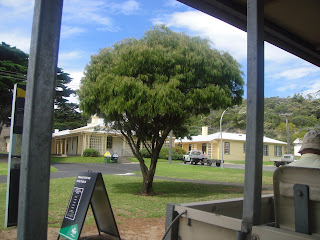But today we decided to check out the Port Nepean National Park, which is right on the tip of the Peninsula.
We boarded the little train that takes you there, its pulled by a tractor...
It has a long history of use by indigenous people and contains a wide number of aboriginal archaeological sites. Historic Point Nepean has spectacular views of the Port Phillip Heads.
It is truly one of Victoria’s beautiful natural landscapes. It is a special place with so much to see and discover. We found out that its history has played an important role in shaping the early settlement, quarantine and defence of Victoria, which we had no idea about till we visited here.
Point Nepean is part of Boonwurrung counrty. The Boonwurrung people lived on and around Point Nepean over 1000's of years ago gathering shellfish and other foods along the coastline.
Extensive shell middens are reminders of their presents so many years ago.
Extensive shell middens are reminders of their presents so many years ago.
A shell midden, which has probably been there for 1000's of years amazing...
It was established in 1852, and was the major place for quarantine purposes in Victoria until 1979 and closed in 1980.
It all started out when in the early 1850's the government established a quarantine station. But before the original building was completed an emigrant ship arrived with many passengers affected by yellow fever.
The ship was the 'Ticonderga' that had left Birkenhead England eighty days before arriving at Point Nepean. She had eight hundred and eleven people on board when she sailed. Because of the lack of the most necessary amenities and over crowding, fever developed amongst the passengers, with the result that they had 96 deaths during the voyage.
When they arrived at portsea on November 6th 1852, the survivors were quarantined, their numbers being so great that tents had to be erected to accommodate the overflow from the existing buildings. Another 82 of the ships passengers died. Deaths were so numerous and sudden that coffins were not available, and burials had to take place without them.
They didn't have the people to dig the graves, so the bodies were placed vertical in recesses in the cliff face and the overhanging bank was then broken away, the resulting landslide burying them.
Today as we look at the buildings they are all empty and locked..
The history is amazing !!
Also on the way was the memorial site for Harold Holt on the 17th December 1967, Harold Holt, Prime Minister of Australia, went for a swim on Cheviot Beach near his holiday home. He disappeared beneath the waves and was never seen again. It was one of the largest search and rescue operations Australia has ever witnessed. Holt’s body was never found.
Check out the stairway in the back ground to the top of the hill
The entrance to Port Phillip Bay was the most heavily forted port of the British Empire. There are many Colonial and Commonwealth structures dated from 1880's to the 1940's located around the park. Fort Nepean is considered to be one of the best examples in Australia of a major fort complex showing the changes in military engineering through the 19th and 20th centuries.
This spot was built in 1892 for a "Quick Firing Gun" it had a rapid rate of fire to prevent the fast moving torpedo boats passing through
Where this gun "barrel 1489" sat it was the first official allied British shot of World War I...On the 5th August 1914...It was fired across the bow of the german steamer ship "Pfalz" when it refused to stop as it tried to go through the heads to avoid capture. It did then spot and was returned to Melbourne !
Barrel "1317" was the first official allied shot to be fired in World War II on 4th September 1939.
These were the only shots fired in anger from the Port Phillip defences...
I could go on and on with the history of this place...much of the barracks etc were all under ground which we explored..
After a long HOT day of exploring we headed back on the train...taking in more breath taking sites.
We had an amazing day, I am just so amazed at the history Melbourne holds..


















No comments:
Post a Comment